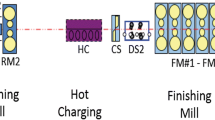Abstract
Bearings are one of the most widely used and highly stressed engineering components. If properly manufactured, mounted, operated and maintained, they can give excellent service life. However, they may suffer from premature failure due to multitudes of reasons. Current work deals with pinpointing failure mode and root cause analysis of a pinch roll bearing at coil box of a Hot Strip Mill. Macroscopic and microscopic analysis revealed that bearing failed in Rolling Contact Fatigue mode. All metallurgical, mechanical and maintenance factors that might contribute to rolling contact fatigue were analyzed independently. It was concluded that misalignment led to accelerated Rolling Contact Fatigue. Striation marks rarely reported for rolling contact fatigue of bearing steels were observed to confirm fatigue mode of failure. Recommendations for preventing similar failures in future have been provided.











Similar content being viewed by others
References
H.K.D.H. Bhadeshia, Steels for bearings. Prog. Mater Sci. 57, 268–435 (2012)
A.B. Jones, Symposium on Testing of Bearings (American Society for Testing and Materials, Philadelphia, 1947), pp. 35–52
E.V. Zeretsky et al., Effect of component differential hardness on rolling-contact fatigue and load capacity, NASA TN D-2640 (National Aeronautics and Space Administration, Washington, DC, 1965)
F. Masi et al., Coupling system dynamics and contact behaviour: Modelling bearings subjected to environmental induced vibrations and ‘false brinelling’ degradation. Mech. Syst. Signal Process. 24, 1068–1080 (2010)
Z. Chang et al., Main failure mode of oil-air lubricated rolling bearing installed in high speed machining. Tribol. Int. 112, 68–74 (2017)
T.A. Harris, M.N. Kotzalas, Rolling Bearing Analysis-Advanced Concepts of Bearing Technology, 5th edn. (Taylor & Francis Group, London, 2006)
W.R. Jones, S.H. Loewenthal, in Ferrographic Analysis of Wear Debris From Full Scale Bearing Fatigue Tests, NASA Technical Paper (1979)
J. Monnot, et al., in Relationship of Melting Practice, Inclusion Type, and Size with Fatigue Resistance of Bearing Steels. Effect of Steel Manufacturing Process on the Quality of Bearing Steels, ASTM STP 987, J.J.C. Hoo (ASTM, Philadelphia, 1988), pp. 149–165
Acknowledgments
Authors are grateful to Tata Steel Limited, Jamshedpur, for the financial support to carry out this work. Authors express their sincere thanks to Dheeraj Kumar Lal, Susovan Das and Vikram Sharma for support in investigation.
Author information
Authors and Affiliations
Corresponding author
Additional information
Publisher's Note
Springer Nature remains neutral with regard to jurisdictional claims in published maps and institutional affiliations.
Rights and permissions
About this article
Cite this article
Kishore, K., Mukhopadhyay, G. Root Cause Failure Analysis of Pinch Roll Bearing at Hot Strip Mill. J Fail. Anal. and Preven. 19, 219–229 (2019). https://doi.org/10.1007/s11668-019-00593-2
Received:
Revised:
Published:
Issue Date:
DOI: https://doi.org/10.1007/s11668-019-00593-2




